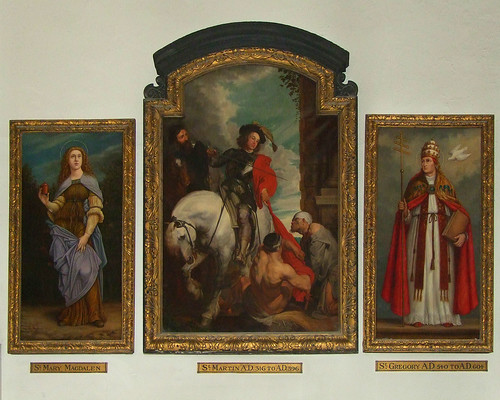
 |
| An occasional saunter
through the churches of the Square Mile |
| home | index | map | latest | about this site | resources | small print | simonknott.co.uk | norfolkchurches.co.uk | suffolkchurches.co.uk |
| St Martin Ludgate |
 |
There are two churches abutting directly onto the street along the northern side of Fleet Street and Ludgate Hill, and St Martin's proximity to the great west front of St Paul's Cathedral erases any doubt you may have that it was completely destroyed in the Great Fire of 1666. It was rebuilt by Christopher Wren between 1677 and 1686. Looking from Ludgate Circus, Wren's perky spirelet is dwarfed by his great replacement cathedral beyond. The tower, and that of St Augustine Watling Street on the other side of the Cathedral, were deliberately intended as foils to the great dome, their diminutive spires creating the illusion that the dome is larger and more distant. St Martin's frontage might lead you to expect that this is a 'west' front turned around ninety degrees so that the church faces north, like the other, St Dunstan in the West. In fact, you step into a narrow narthex, and the stairs lead you up into the south side of the nave. At first sight, the interior is rather unexciting - dark and gloomy even - but St Martin suffered less damage from the Blitz than any other City church, and so what you see today is essentially Wren's interior, albeit augmented by the Georgians and Victorians. It would be possible to entertain a romantic notion that the little church had been sheltered by its giant neighbour, but of course Christ Church Newgate Street and St Augustine Watling Street, which were similarly close, were both destroyed, and the interior of St Vedast alias Foster at the east end of the cathedral was gutted in the fire storm. The font is dated 1673 and inscribed The gift of Thomas Morley Esq. Around the bowl, the Greek palindrome NIYON ANOMHMA MH MONAN OYIN ('cleanse my sin and not my face only'). The grand west gallery dominates one end, with a large candelabra hovering over the furnishings, some of which came from St Mary Magdalen in Fish Lane, demolished in the 19th Century. Once you know that St Martin is a great survivor, you become more sympathetic to the atmosphere of the interior, dusty as it is and creaking with age. Why, this might be the very church of which Betjeman reminisced in Summoned by Bells: 'A single bell would tinkle down a lane: My echoing steps would track the source of sound - A cassocked verger, bell-rope in his hands, called me to high box pews, to cedar wood (Like incense where no incense ever burned), To ticking gallery clock, and charity bench, And free seats for the poor, and altar-piece - Gilded Commandment boards - and sword-rests made For long-discarded aldermanic pomp. A hidden organist sent reedy notes To flute around the plasterwork. I stood, And from the sea of pews a single head With cherries nodding on a black straw hat Rose in a neighbouring pew. The caretaker? Or the sole resident parishioner? And so once more, as for three hundred years, This carven wood, these grey memorial'd walls Heard once again the Book of Common Prayer, While somewhere at the back the verger, now Turned Parish Clerk, would rumble out "Amen".' Simon Knott, March 2022
Commission
from Amazon.co.uk supports the running of this site |
| home | index | map | latest | about this site | resources | small print | simonknott.co.uk | norfolkchurches.co.uk | suffolkchurches.co.uk |
 |
| An occasional saunter
through the churches of the Square Mile |